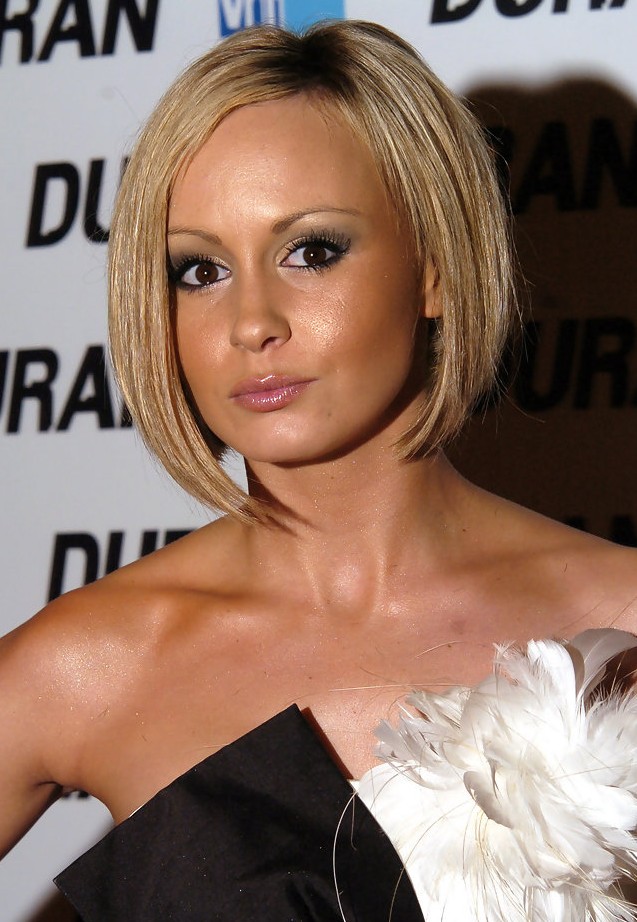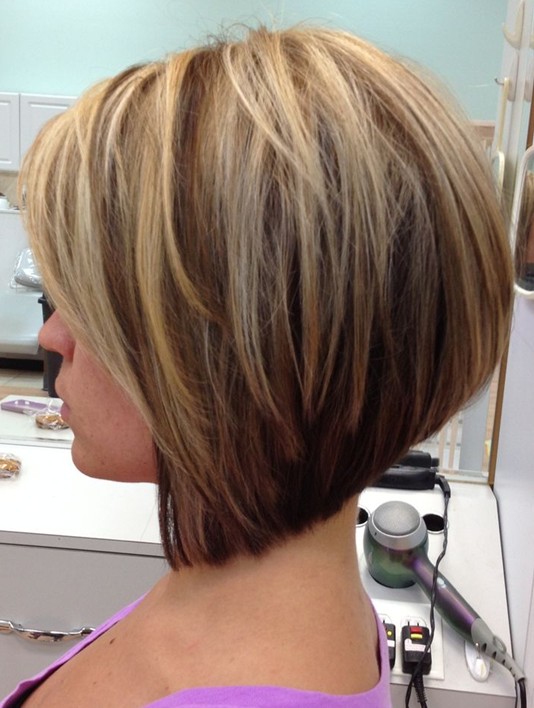 Inverted Bob Hairstyles Weeklyhttp://hairstylesweekly.com/images/2012/06/Short-Inverted-Bob-Haircut.jpg
Inverted Bob Hairstyles Weeklyhttp://hairstylesweekly.com/images/2012/06/Short-Inverted-Bob-Haircut.jpg
Bob Hairstyles Haircuts
A hair, hairdo, or haircut identifies the styling of mane, on the human being scalp usually. Sometimes, this could signify an editing of beard mane also. The fashioning of hair can be viewed as an element of personal grooming, fashion, and cosmetics, although practical, cultural, and popular considerations also influence some hairstyles. The oldest known depiction of hair braiding goes back about 30,000 years. In historic civilizations, women's head of hair was often elaborately and carefully dressed up in special ways. In Imperial Rome, women used their mane in complicated styles. From enough time of the Roman Empire[citation needed] until the Middle Ages, a lot of women grew their hair as long as it would obviously increase. Through the Roman Empire as well as in the 16th century in the western world, women started to wear their hair in extremely ornate styles. Inside the later half of the 15th century and on into the 16th century an extremely high hairline on the forehead was considered attractive. During the 15th and 16th centuries, Western men wore their hair cropped no longer than shoulder-length. In the first 17th century male hairstyles grew longer, with waves or curls being considered desirable.
The male wig was pioneered by Ruler Louis XIII of France (1601-1643) in 1624. Periwigs or perukes for men were introduced in to the English-speaking world with other French styles in 1660. 17th-century wigs were very long and wavy late, but became shorter in the mid-18th century, where time they were normally white. Short hair for fashionable men was a product of the Neoclassical movement. In the early 19th hundred years the guy beard, and moustaches and sideburns also, made a solid reappearance. From 16th to the 19th hundred years, European women's scalp became more visible while their scalp coverings grew smaller. In the center of the 18th hundred years the pouf style developed. During the First World War, women around the world started to shift to shorter hairstyles that were easier to manage. In the first 1950s women's hair was generally curled and worn in a variety of styles and lengths. In the 1960s, many women began to wear their hair in a nutshell modern cuts including the pixie cut, within the 1970s, scalp tended to looser be longer and. In both 1960s and 1970s a lot of men and women wore their hair very long and straight. Within the 1980s, women pulled back their hair with scrunchies. During the 1980s, punk hairstyles were followed by some individuals.
Throughout times, people have worn their head of hair in a wide variety of styles, largely determined by the fashions of the culture they live in. Hairstyles are markers and signifiers of social class, age, marital status, racial identification, political beliefs, and attitudes about gender.
In many civilizations, for religious reasons often, women's head of hair is covered while in public, and in a few, such as Haredi Judaism or Western Orthodox neighborhoods, women's locks is shaved or minimize very short, and protected with wigs.Only since the end of World Battle I've women begun to wear their hair short and in rather natural styles.
Paleolithic
- The oldest known duplication of wild hair braiding lies again about 30,000 years: the Venus of Willendorf, known in academia as the Woman of Willendorf now, of a female figurine from the Paleolithic, estimated to get been made between about 28,000 and 25,000 BCE.The Venus of Brassempouy counts about 25,000 yrs . old and shows hairstyling indisputably.
Bronze Age
- In Bronze Era razors were known and in use by some men, but not on a daily basis since the technique was rather annoying and required resharpening of the tool which reduced its endurance.
Ancient history
- In early civilizations, women's locks was often elaborately and carefully dressed up in special ways. Women colored their wild hair, curled it, and pinned it up (ponytail) in many ways. They place their hair in curls and waves using damp clay, which they dried out in sunlight and combed out then, or else by utilizing a jelly manufactured from quince seeds soaked in drinking water, or styling tongs and styling irons of varied kinds.
Roman Empire and Middle Ages
- Between 27 BC and 102 Advertisement, in Imperial Rome, women wore their mane in complicated styles: scores of curls on top, or in rows of waves, attracted back into ringlets or braids. Eventually noblewomen's hairstyles grew so complex that they required daily attention from several slaves and a stylist in order to be maintained. The scalp was often lightened using hardwood ash, unslaked lime and sodium bicarbonate, or darkened with copper filings, oak-apples or leeches marinated in wine and vinegar. It had been augmented by wigs, pads and hairpieces, and held set up by nets, pins, combs and pomade. Under the Byzantine Empire, noblewomen covered the majority of their hair with silk caps and pearl nets.
Best HAIRSTYLES For Short Hair Women
- It is vital to choose the best short hair styles for women since it takes on an enormous part of your look. Having the right hairstyle can provide you with pleasure and positive feelings. Find out which hairstyle is perfect for your personality and character. You should also consult your hairstylist before having a new haircut. After all, changes are excellent and it can truly add positive outlook in your life also. Feel absolve to browse our collection of short hairstyles for women and choose the one that your like best.
2014 Stacked Bob Haircut for Straight Hair PoPular Haircuts
 http://pophaircuts.com/images/2013/10/2014-Stacked-Bob-Haircut-for-Straight-Hair.jpg
http://pophaircuts.com/images/2013/10/2014-Stacked-Bob-Haircut-for-Straight-Hair.jpgshort layered bob hairstyles front and back view Hollywood Official
 http://www.hollywoodofficial.com/wp-content/uploads/2014/09/short-layered-bob-hairstyles-front-and-back-view-800x1024.jpg
http://www.hollywoodofficial.com/wp-content/uploads/2014/09/short-layered-bob-hairstyles-front-and-back-view-800x1024.jpgshort layered bob hairstyles front and back view Hollywood Official
 http://www.hollywoodofficial.com/wp-content/uploads/2014/09/short-layered-bob-hairstyles-front-and-back-view-800x1024.jpg
http://www.hollywoodofficial.com/wp-content/uploads/2014/09/short-layered-bob-hairstyles-front-and-back-view-800x1024.jpgNEW SHORT HAIRSTYLES: SHORT BOB HAIRCUTS: TYPES AND STYLES
 https://blogger.googleusercontent.com/img/b/R29vZ2xl/AVvXsEiPc3JZHqS4fOajRTAMTpV7r9BCsmqtzXdYrsFralWAsmwbCng8afXQZBCLF4ewmDCuET9O2kz2V0UeRDddjHqUChX_9oEMANEyVE5_0oC6h8P5iYT09j2Rz5aqAV0OVx8zByd6RblorMs/s640/Inverted-Bob-Haircuts-1.jpg
https://blogger.googleusercontent.com/img/b/R29vZ2xl/AVvXsEiPc3JZHqS4fOajRTAMTpV7r9BCsmqtzXdYrsFralWAsmwbCng8afXQZBCLF4ewmDCuET9O2kz2V0UeRDddjHqUChX_9oEMANEyVE5_0oC6h8P5iYT09j2Rz5aqAV0OVx8zByd6RblorMs/s640/Inverted-Bob-Haircuts-1.jpgOIP.M0eba628c3f7cf1cae5f986eaf3af9beaH1
1513B77FE102513107CE1B2C88EE47C9E78F0A897Fhttp://hairstylesweekly.com/inverted-bob/
Embed Our image to your website
ThumbnailImageEmbed Our image to a Forum
ThumbnailImage








.jpg)
.jpg)

